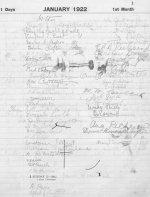The BC Adventure 22

By jeand
- 1553 reads
Vesuvius
January 10, 1922
Dear Mums, Daddy and Dorothy,
We had a lovely Christmas period. Thank you so much for the thoughtful presents. They will be very useful.
On the 31st we went to Beryl's birthday party. She was 23. She had all who were there, 40 or so of us, sign her diary. So our signatures will become part of Salt Spring history for years to come.
Who knows who might be reading her diaries in the 21st century. She certainly is faithful to them.
This weekend we are starting dancing lessons at Harbour House.
Mark had an update on the situation in the Cariboo. Albert Platt and John Lyne have been there since September, and their takings are quite remarkable. But our plan is still that Mark should go out there with the rest of the team about July 1st.
We met up with Mary Gyves, who is an Indian. She told us about how things were back when she was young. She was born in 1845 in the area around Burgoyne Bay was her father's camp. She said, “We owned the property and stayed there. Some people think the Indians only used the land occasionally, but that wasn't true. If someone wanted to use our land to dig clams or something they had to get permission. And if we wanted to use the harbour at Fulford, we would have to ask permission of the Indians who lived there.”
Mark asked her about what her father did for a living. She said, “His camp was located next to
the creek at the head of the bay that sported a run of coho and chum. The creek was narrow and they were easy to catch. They’d just use a gaff. You could easily see the fish. They used to dry them. And the clams were another big source of food.”
“How did you use them?” I asked.
“They used to come into Burgoyne to dry clams. They used to make a fire on the rocks, heat them up and dump a basket of clams on them, put seaweed on top and more clams and seaweed on top of that and the steam would open them up. Then they’d take them out of the shell and they’d thread them on strips of cedar bark, they used the inside cedar bark, the white inner bark. Then they’d string the threaded clams between racks over a smoking fire. If it was September, they wouldn’t even need a fire when the sun is really hot. The clams would be dried to a golden brown and they’d hang the threaded clams up in the attic.
“Something else we ate were the purple-flowered Camas bulb an these grew on the oak
meadows along the south side of Mount Maxwell.
“The season was short – three weeks or less. Harvesting of camas was a co-operative effort – large quantities had to be dug and processed over a number of days. Once cooked, the camas became sweet-tasting. .
“They used to burn off that area above Burgoyne under Maxwell Peak. They’d burn all that – several acres. After, the ashes cooled, it made a good seed bed for the camas and they’d put seed in and they would go in the spring and dig it up. After it was dried I would grind it into flour in a stone bowl.
“They used the stone bowl again in the fall of the year when there was a lot of sugar in the salal berries. They’d mash them in the stone bowl and then they’d dry them in the sun into cookies. They used all kinds of berries – anything that had a lot of sugar, which would preserve them. “Mostly salal, taatka , also salmonberries.
“The burning was good for attracting deer. When you kept big open spaces like that full of salal, and Oregon grape the deer would come in. Where it was heavy timbered country, the deer wouldn’t come in.
“Another thing we did was to make paint from a red ochre rock located behind the bay We’d scrape the rock and it would come off as a fine sand. Then we’d put it into a stone paint dish and rub it into a very fine powder, and mix fish or seal oil in and we’d have a paint. If we wanted different colours,we’d boil cherry bark for black, or moss for green, and mix it in.”
All I can think of to write for now.
Love,
Gwenllian
- Log in to post comments
Comments
it's interesting to see how
it's interesting to see how others lived and how easily they were brushed aside because the white man needed land - and so they took it.
- Log in to post comments
All very interesting. Mary
All very interesting. Mary was settled into the community? Married? Rhiannon
- Log in to post comments
This was most interesting
This was most interesting Jean, I loved all the descriptions of how they prepared the clams. Also how they made paint from the red ochre rock, or used other plant life to change the colour. Never realised that that you could use fish or seal oil to turn it into paint.
I boiled down some tansy flowers to make a yellow dye once, it worked pretty well, but the dye ran pretty bad every time I washed the tops I dyed. I was very much into the American Indians at the time, but I think I've already told you about that.
Anyway I enjoyed reading this and thank you for sharing.
Jenny.
- Log in to post comments


